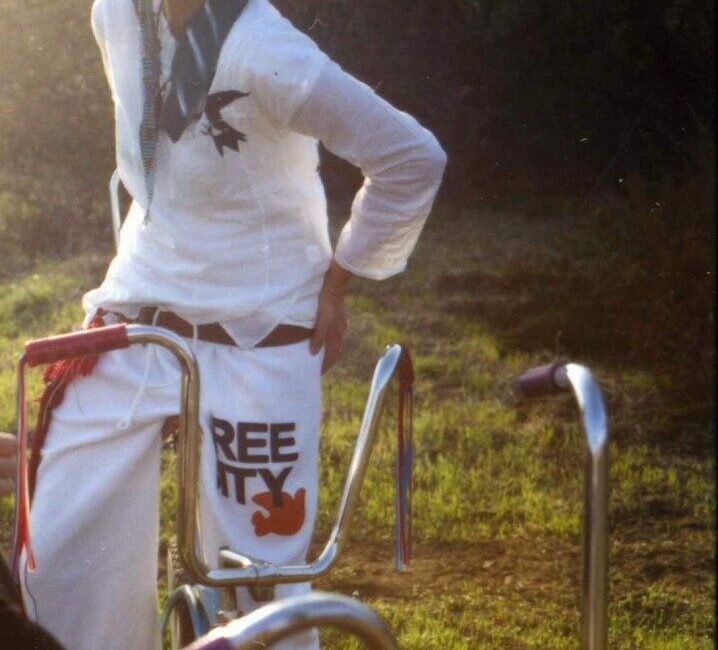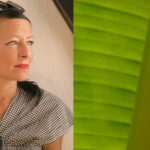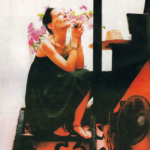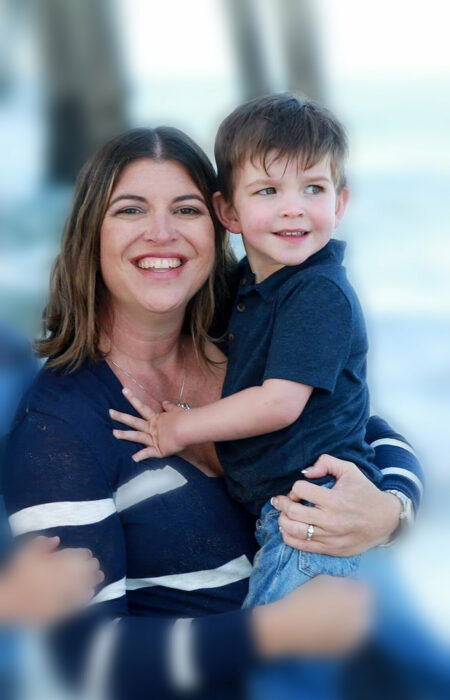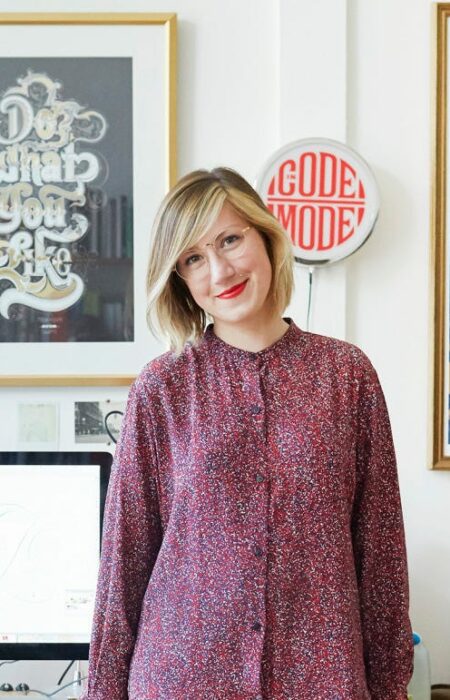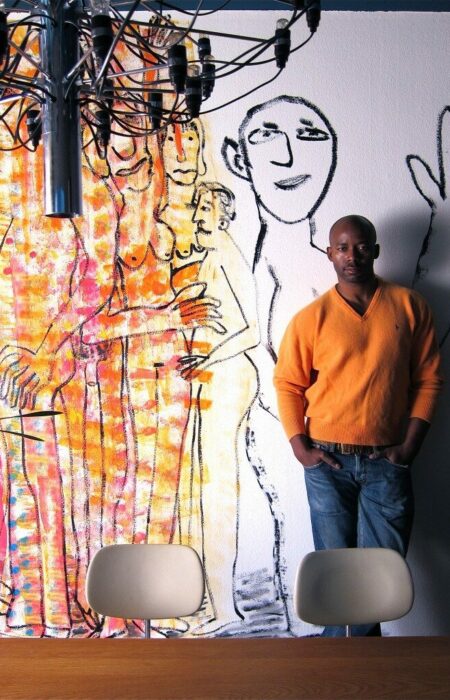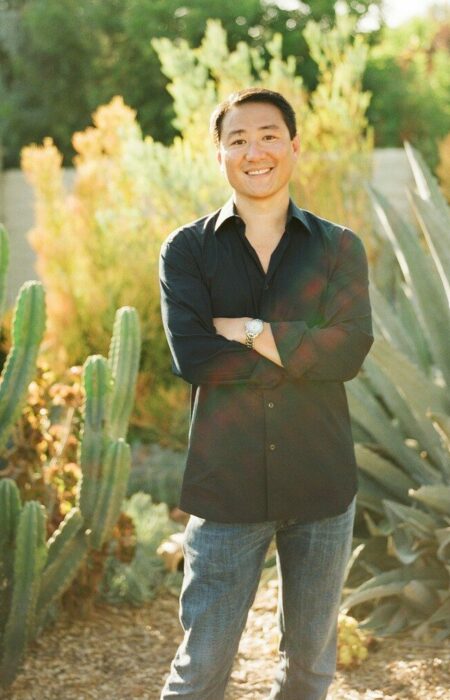Nina Garduno is a creative optimist whose soulful approach to business is regarded by many as prescient. Her FREECITYsupershop, located in Malibu, is conceptually part artistic commune and part transcendent experience. A former buyer for Fred Segal and Ron Herman in Los Angeles, Nina’s dislike of ‘who-cares commerce’ continually challenges her to take retail beyond itself. Drawing inspiration from her childhood growing up in bohemian Laurel Canyon and from her travels around the world, Nina has created a global destination and a world within a world where everything is possible.
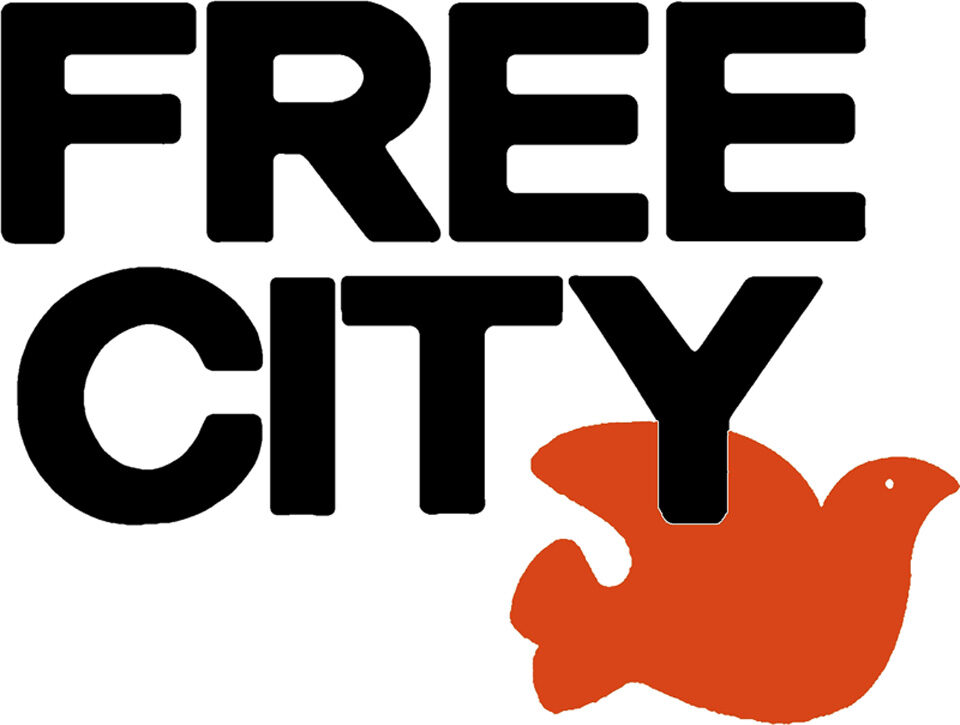
FREECITYsupershop dove
Find an expanded interview with Nina Garduno in my new book Field Trip:Volume One, available on Amazon here! Or read more about my new book here.
You’re thought of as a trendsetter, a merchandiser, a buyer, a designer and creator, a curator. How do you think of your work?
Well, it depends. I mean, how I feel about my work now is that it’s more art-bound than it’s ever been before. And it’s about small groups of people being able to make the impossible happen. So it’s kind of keeping the ethic that all things are possible.
I’ve got a workshop in Hollywood, and there are about eight people that work in this workshop. And I’ve got a print shop downtown which does all the print. We make everything — from clothes to bicycles to structures to flags to tents to furniture, everything — and none of us really went to school for it. So it’s kind of like, ‘how do we do it?’ We get an idea of what it’s going to be and then it’s just kind of brainstorming about how we can make it happen, with all of our limitations — whether they’re financial limitations or just downright abilities — and trying to bring it to its highest possibility. So it’s kind of like very simple elements, bringing them to their highest possibility, with a super high expectation of the result and kind of keeping that ethic. So for me, it’s keeping the ethic, keeping the bar high, and trying to reach the bar. It’s really rewarding like that. I don’t know that it’s very different from what I’ve ever done in the past, but I think it’s always been about taking the harder road. Because ‘easy’ has never been challenging for me. I’ve never been excited about easy, so the challenge is that it’s hard.
For instance, we did the Natural FREECITY History Museum. We redo the store once a year in August because we opened the store in August four years ago, so we take an idea like that. And in this case it’s about really making it authentic, as authentic as possible to a real natural history museum. It’s just FREECITY’s take on it. So we made dioramas, we made Peking Man, and we made a lion — everything that goes along with that. And we didn’t use taxidermy or anything like that, so it’s about ‘how do you make that item not look like a stuffed animal?’ How do you make it real, as real as possible?
So it’s like a snowglobe, the store itself is like a snowglobe. That’s why we call it a supershop — it’s a small space, about 1500 square feet that anything can happen in. So if you keep that mindset and keep all possibilities open, you can make really extraordinary things. And that sounds totally cliché, but it’s true. That is what we’re doing. A lot of people think, being that we live in L.A., that we just got a prop house and borrowed stuff. But we didn’t. We made it all from scratch. For me, it’s very rewarding to know we made it happen.
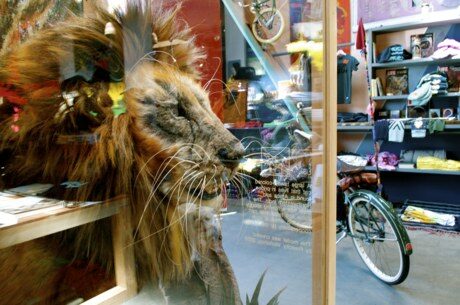
Lion in the Natural FREECITY History Museum show
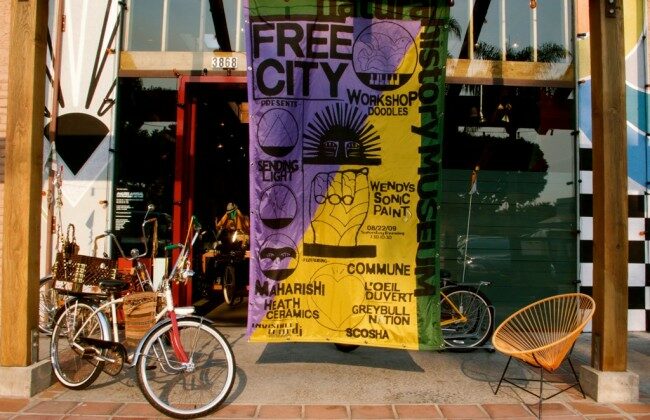
Front exterior of FREECITYsupershop, created by Nina Garduno
I understand the initial inspiration for FREECITYsupershop came from your travels, in particular to the commune Fristaden (‘free city’) Christiania in Copenhagen. How did this go from an initial feeling and revelation to actually opening your shop in 2005?
I think the revelation was that I’d been to places like that all my life, and it all clicked in one moment. When I went there in particular, somebody said, ‘Have you been to the free city?’, and I went ‘No, but what’s the free city?’ I was in Paris at the time on a buying trip and I had a few days, and I thought ‘I’ll go see it, whatever this is in Copenhagen.’ So I went to go see it, and the inspiration was that it was a collective group of people living like they checked the ‘other’ box. And it was like, ‘Wow, it can be anything.’
You know, why are we into this structure of city, or what it’s supposed to look like — it can be anything we want! So that was the inspiration, and I realized there are places like that everywhere. Some are based in architecture, some are based in religion, some are based in agriculture, some are based in total looney-zone, nudist colonies — it doesn’t matter. The point is that people are choosing to live a different life and making it happen. And I love that. So if I don’t want to move and go live in a commune or a kibbutz, how can I feel that feeling? So what happened to me was that it was a feeling. And if I want to live that feeling, I can live it anywhere. So FREECITY is a state of mind, it’s more of a feeling — and it’s personal.
And I think that’s the thing about the words. The words are personal — it’s not a brand for me, even though people call it a brand. It’s not a gimmick or a slogan. It’s a state of mind, it’s your own. My FREECITY is mine, your FREECITY is yours. And to keep it that way is what’s been the challenge: to keep it personal, to keep it so that it doesn’t feel commercial. So that I never get into that commerce thing that I hate so much, where people are buying stuff just to buy it, consumption for consumption’s sake. That for me is the biggest turn-off. You know, I change the labels all the time inside what I make to keep that purity about FREECITY. FREECITY is like the umbrella, and everything underneath it is kind of like what lives in FREECITY.
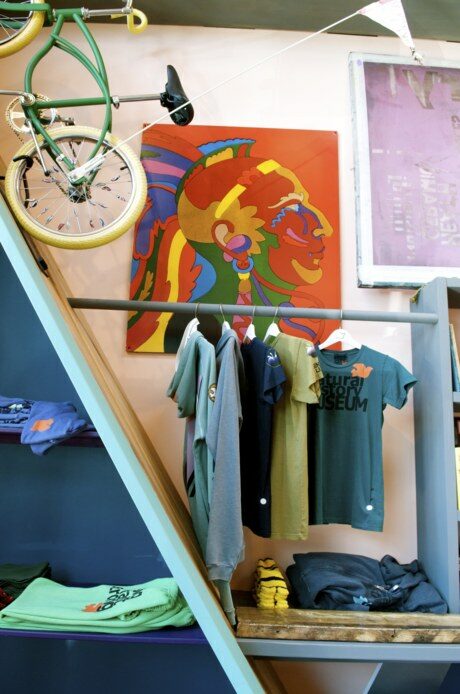
Interior at FREECITYsupershop, created by Nina Garduno
So did you realize early on that this was going to be a shop? Or did you have other ideas about what this concept could be?
Well, you know what? Yeah, I had many ideas of what this could be. One of which — and why I’m so attracted to what Liz [Lambert] does — was a big, broad piece of land, where anything could happen on that piece of land. Which is what Liz is realizing with El Cosmico. And I admire so much of what she does because she’s doing it, against all odds. Nonconformist, making it happen, and getting like-minded people to seize their own possibilities, and then make something very special and beautiful on a high level. She’s doing these trailers, but it’s not just a trailer park. It’s ‘how can you make that trailer incredible?’ So for her to bring it to that potential is really inspiring to me.
So a body of land and to do the projects on the land, and then clear the space and do another project on the land was the first idea. And that’s actually what brought me to Marfa, because I was looking for a little piece of land to do that in New Mexico — because anything can happen in New Mexico — but it just didn’t seem like the right place. Then I took a trip through Marfa, and we ended up buying a little piece of land there. That place is a free city, Marfa is a free city. It happens to be full of artists and creative people and regular people. It’s kind of like this ghost town that became something. And it’s like-minded. So for me, I live in one, or I have a place in one. It is a free city.
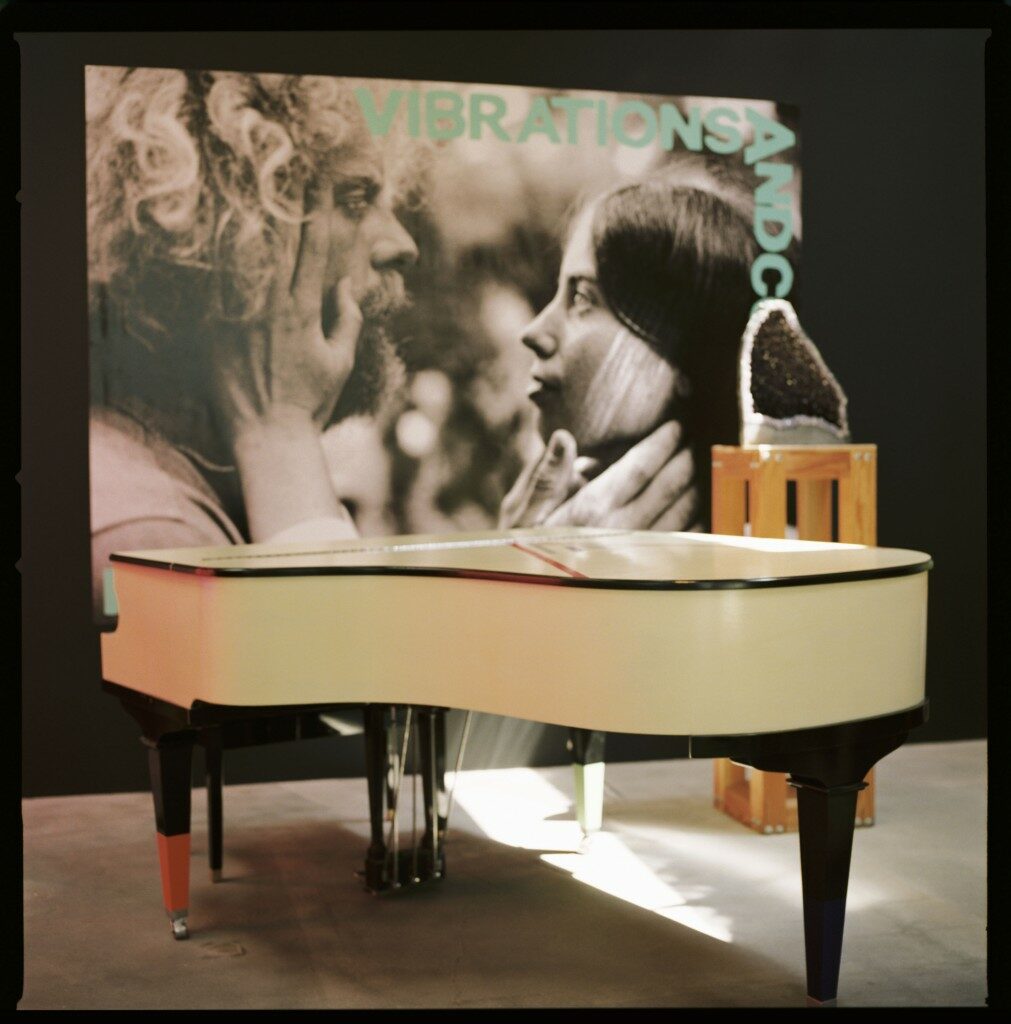
The INMUSICINLOVE VIBRATIONSANDCOLOR show at FREECITYsupershop
It’s clearly as much an experience as it is a shop. And the way you talk about love and faith, it strikes me that your creations are like physical expressions of this feeling. Is this a fair description of your intent?
Yeah, the intention is to totally be telling the truth. So it’s like about honor and telling the truth. And if it’s wavering off that and going into some other category, I throw it away and try to bring it back to that other quality. And I think because of that, it takes me on that other road inherently, because you have to have faith.
And, by the way, I fall into lack of faith while we’re creating the experience, especially with this last thing we did, because I was afraid to do Peking Man or these Neanderthal-type creatures. Because I went to New York to the Natural History Museum, and, oh, my god, it’s really incredible. They’re like the unsung heroes, the people that do those museums, because the dioramas are incredible, the sculptures are incredible. Just the celebration of the universe, and not just humans but also incredible animals and things that fall from the sky. It’s like the most amazing thing that somebody thought of to do a natural history museum — it’s insane! They’re so great.
Anyway, I saw these two people, a diorama, of the first walking man. It was a man and a woman, and it touched me so, it was so pure and so optimistic. You know, coming out of all this darkness that we’ve all gone through, it was like, how can I achieve that? And I was worried — are people going to freak out because I’m showing genitals, or it’s scary because they look like monsters, or whatever, right? And it came down to, it can’t be a natural history museum without the first man — I mean, it just can’t. And I added more fur, but to put it in clothes or put a garment on it, it would just be a mannequin, a Barneys window. So to keep it true, there was a lot of fear around it, and people that I work with helped me through it. To have faith, and have faith that it’s the right choice, and to not be driven by what other people think of the end result. Some people walk in and go, ‘oh, my god, that scared me,’ and some people walk in and they’re so amazed. That is the point — I don’t need a guarantee, but sometimes I fall into the fear.
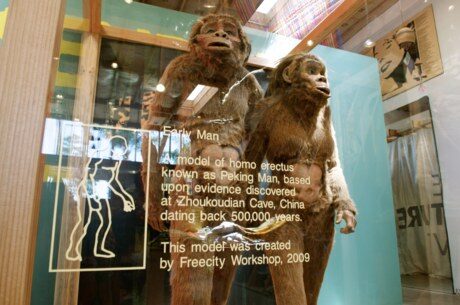
Peking Man display at Natural FREECITY History Museum
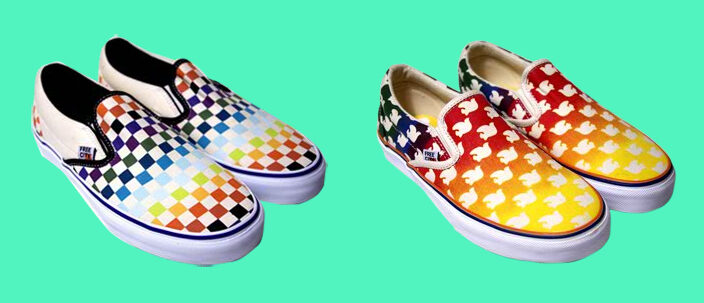
FREECITYsupershop sneakers
In this case, it wasn’t the fear that you could pull off your vision, it was more a fear of what other people might think?
Well, I don’t know! It’s both. Just to pull off the vision would be that it rises above somebody’s impression of it. That it rises above all of that. That it goes into another realm of appreciation, instead of just that blanket opinion, which is easy to happen in a retail environment. Because I don’t have a museum — I have a thing that people can buy things in. So I’m sitting there with a lot of critical eyes because they’re purchasing something. So I kind of went about this feeling like everything in the store is either a relic or a souvenir of the experience, so it was like making souvenirs. So the challenge is to get it to a point where it’s beyond retail, it’s beyond shopping, it’s beyond commerce — and it can take you somewhere, into an experience. Getting it to rise above a blanket critique, and I’m sure it happens, so I have to remind myself of that because the stakes are high. I’m not confused — and I don’t think Liz is either, or anyone who does something similar to this — that to keep the door open and to keep the ‘exhibit’ alive, I’ve gotta ring the register. So there is commerce involved, but there is with the museum as well — they may call it a donation, but you’re still paying $2 or $7 when you go. Not always, but there’s commerce involved, and we’ve gotta make the money to keep the door open. It’s a funny balance.
I want to take this love question a bit further. I wondered if part of your mission with FREECITYsupershop is a reaction to the mass-production of things made without love?
A hundred percent. That’s a really great way of putting it, as a matter of fact. The wrong in what I make is the right of what I make. And there’s a fine line between them. And whether I’m making something that’s hand-screened or we mix every color from pigment, it’s got a lot of hand to everything we make. So for someone to look at it and be critical and go, ‘oh, this is defective’, and you go, ‘well, there’s a fine line between defective and beautiful.’ So when we’re doing our quality control, that is the defining difference: is it beautiful? So if it isn’t and it didn’t fall into that category, then we throw it out — it didn’t work. Yeah, love — love is important. The bottom line is that, you know, that’s really all that matters, isn’t it?

Love in the Quoddy boots at FREECITYsupershop
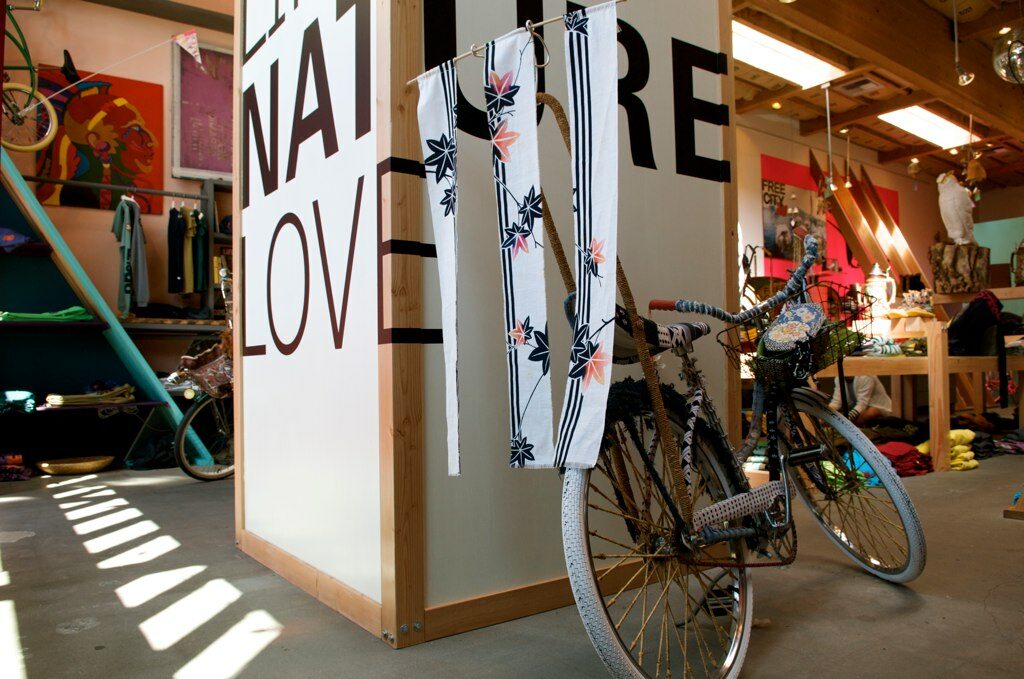
LifeNatureLove at FREECITYsupershop
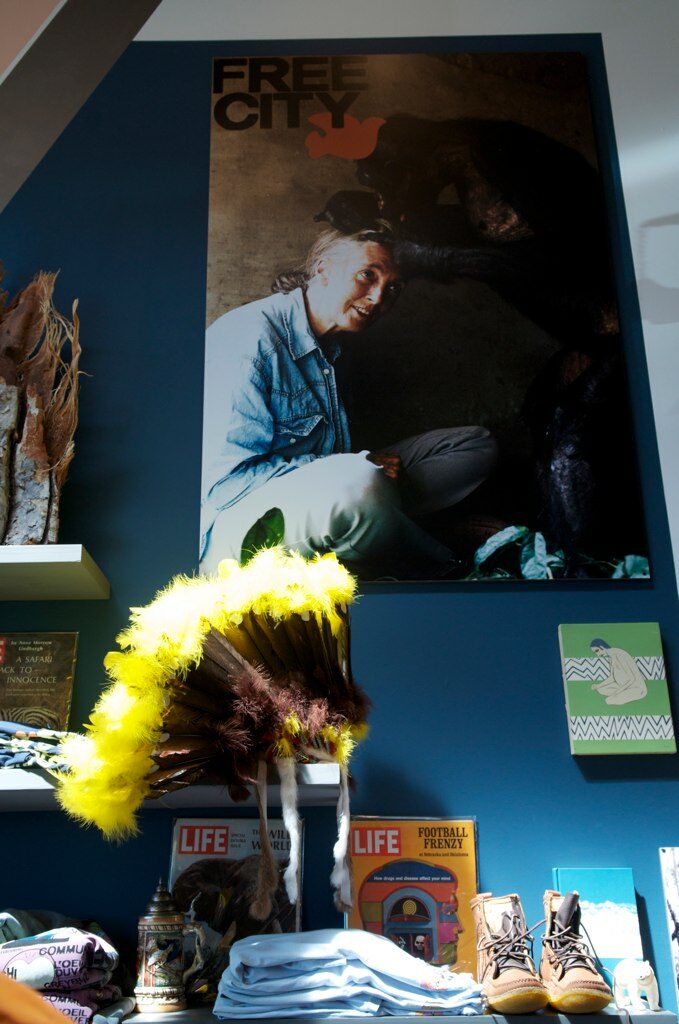
More life, nature, and love at FREECITYsupershop
Words play a big role in the graphics you print and in the shop interior, but I understand words are also the starting point for a lot of your concepts. How do these word concepts come to you, and how many of them actually come to fruition?
Oh, boy. Again, I stick with FREECITY as the umbrella to all things possible. So I’ve had four different shows now. The first one was TEXASTOKYO TOKYOTEXAS, and that came from an inspiration from a trip I took to Japan, and I had just come from Marfa. And I saw a show there in Japan that was BerlinTokyo TokyoBerlin. So the whole thing was really interesting about these two places that are so very different, and what happens when they come together? And actually, in the end, they’re not that different — they’re like-minded. So that was my inspiration for that. And then, of course, you find everything that has to do with it. For instance, we made a teepee that was gold-flaked and hand-screened, with fresh-cut, giant bamboo. So there’s your combination, there’s the mix, in a physical sculpture.
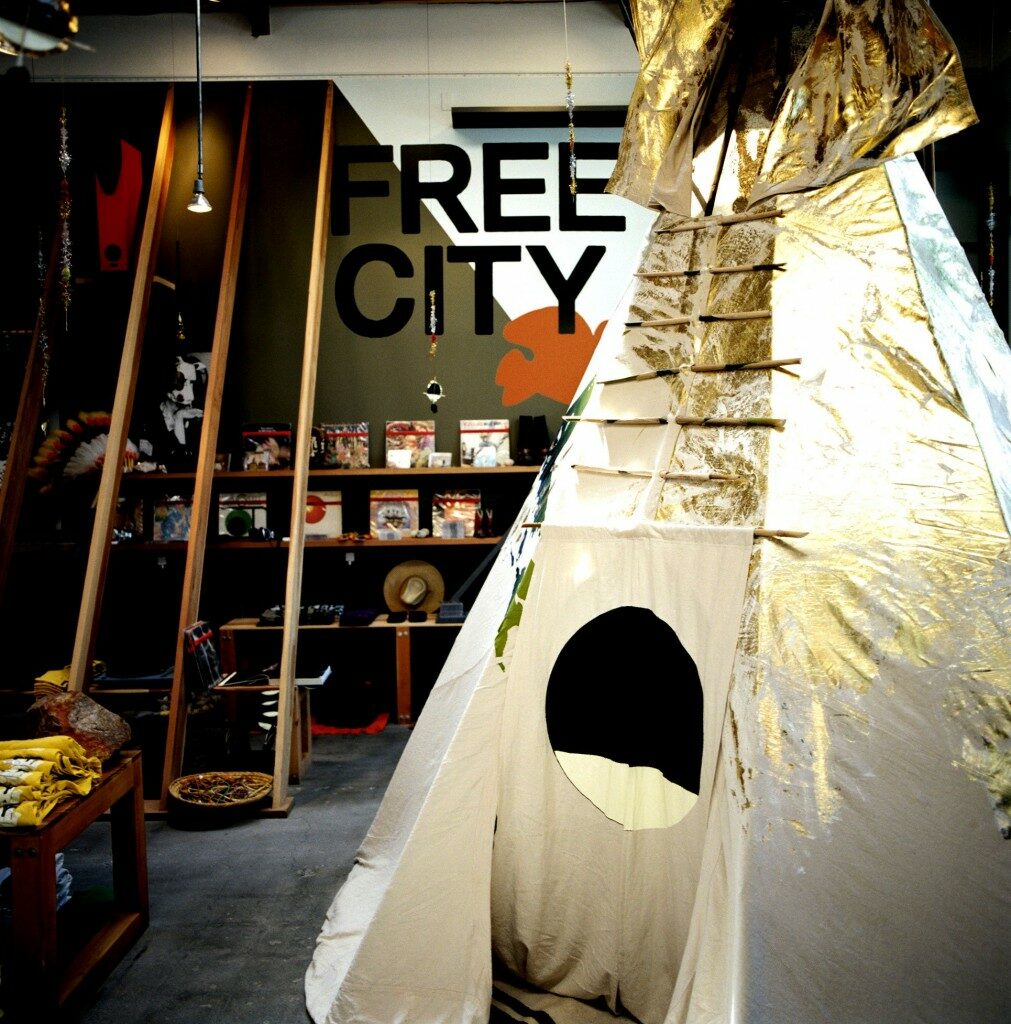
Part of the TEXASTOKYO TOKYOTEXAS show at FREECITYsupershop
So the words are very crucial, the words are important. And one of the things that is my pet peeve about copycat resources now is that they don’t care about the words! In the words “Let’s go,” which I kind of put on a lot of what we make, it’s you and me together, let’s go together. So it’s very inclusive, and I think it is based in goodness.
You know, I’m not interested in t-shirts that say ‘Bitch’ — I’m just not interested in it. And particularly in what we just made with the Natural FREECITY History Museum, putting a lot of animals on things could be a super easy solution to making that concept happen. But, ok, what if you don’t do that? What if you tie your hands and go, ‘I’m not going to do that.’ Then what is it? What is the core of the beginning of all things? And we came up with ‘Big Fast Strong.’ Big, bigger, biggest, Fast, faster, fastest, Strong, stronger, strongest. It’s like the common denominator to all things, and underneath that realm of a natural history museum is survival of the fittest. And so that became a big handle for the whole thing. And then ‘Sending Light.’ It’s the two phrases together — it’s the Natural FREECITY History Museum/Sending Light. Behind the Peking Man, on the wall it says Sending Light. I mean, when man stood up and walked together, it’s the most optimistic possibility. It’s like the beginning. And I think there is a lot of goodness in the world, so it is about sending light and all those things. It can sound corny — but I’m a believer, what can I tell you!
This was the name of our last show, Believers, which had to do with pop art and a common experience that happened through the world in the late ’60s and early ’70s. The first yogi came to America, and it’s about religion and belief systems and breaking down belief systems and just everything. So it’s amazing what you can collect under an idea.
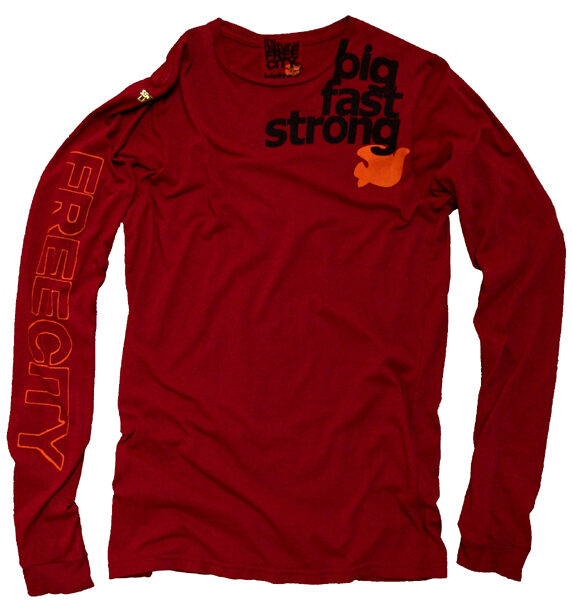
BigFastStrong t-shirt at FREECITYsupershop
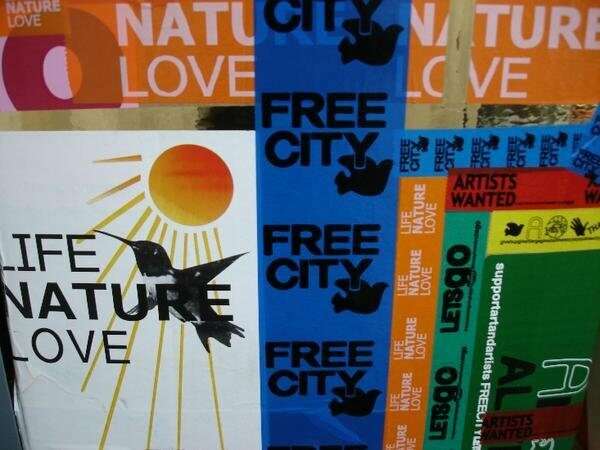
Word concepts at FREECITYsupershop, created by Nina Garduno
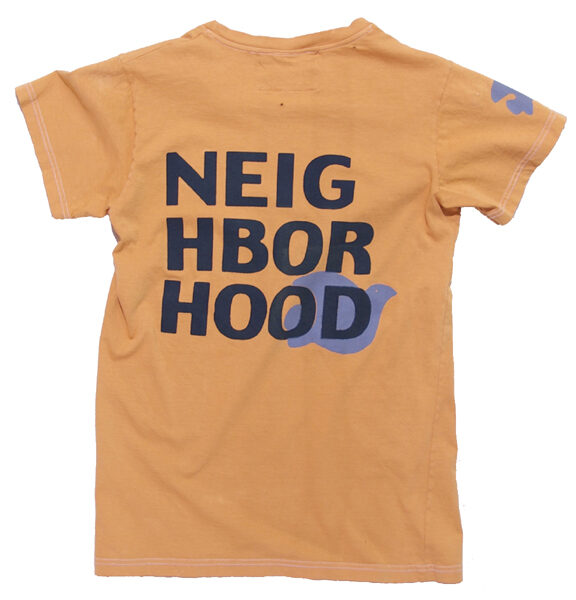
NEIGHBORHOOD t-shirt at FREECITYsupershop
This seems to be an interesting era in design, where some of the most successful creations are ones that get shaped in an unpredictable fashion by human community and interaction, which we’re seeing a lot of with technology now. I know you freely invite people in to simply experience the shop, and the local surfers help themselves to the oranges you put out. To what degree is FREECITYsupershop being shaped by this interaction?
Well, I draw on different artists and invite different people to help. For instance, there’s an artisan fragrance I have in the store called L’Oeil du Vert made by Haley Alexander van Oosten, and it’s incredible what she makes. And I’m not just talking about natural fragrances, I’m talking about the real thing. Haley has plants in her studio/lab that she’s extracting oils from — the real deal. She’s flying to India for plants, she’s flying to Hawaii for plants — Haley is a very brilliant woman. So I’ll give her a phrase, and she’ll come up with a fragrance for it. And they’re very expensive. Haley did a whole thing called Carmot, which is five different fragrances, and they’re very beautifully made. There’s a glass interior and a wooden vile — it’s crazy what Haley does. And it was $5000 for the whole thing, and just the basic thing she made for us was $850. It’s like the right people can’t always afford it, but they are drawn to it. And then those that can, buy it, because they understand the rarity.
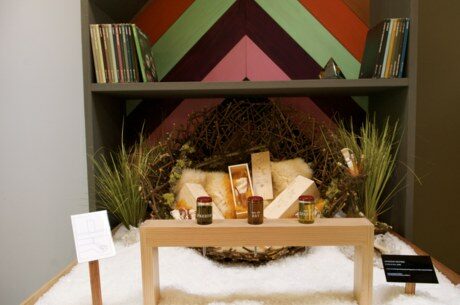
L’oeil du Vert fragrance at FREECITYsupershop
And there’s a few other people I’ve invited to do stuff too, like Clare Rojas — she’s a painter who lent some of her paintings. And they’re not just coffee shop paintings — I mean, this is the real deal. Scosha, who does jewelry — she’s brilliant. She did the most beautiful jewelry for the last show we had. Wendy — from Wendy and Lisa, if you’re familiar with Prince and the Revolution — she did the music for this particular show, and there’s a soundtrack that lasts the entire year until next August. Because everytime somebody comes in, they’re hearing it for the first time, and it’s part of the total. So she developed the music for that. I did a collaboration with Maharishi and Heath Ceramics. And I don’t know if you know how hard it is to get these people to do a small little thing with you. I’m honored every time that people say yes to that. Lisa Eisner, who’s incredible, she’s always working with us on every show that we do. Commune worked with us — they developed the nap bag for us. So it’s like we’re all showing up for each other to make something real. And it’s so rewarding in that way.
We made less money this year than we did last year, but my heart’s fuller. I got something out of it different this year. And just people walking in the store, there isn’t a day that I don’t go in there — and they don’t know that I make it — that somebody doesn’t go ‘I drove from Orange County,’ or ‘I flew my family from Michigan because this is all my daughter wanted,’ or ‘We wanted to see the store.’ I mean, I’ve had people cry! People have cried in there. I’ve heard many times, ‘This reminds me of something. This is me, this is me, there’s something about this that is myself.’ And, you know, kids don’t need to explain it or have it explained — they get it right away. But sometimes adults will be like, ‘what is it?’ And they may think I’m being difficult, but it doesn’t really matter what it means to me, it matters what it means to you. What you take from it is the most important thing. Who cares what it means to me?
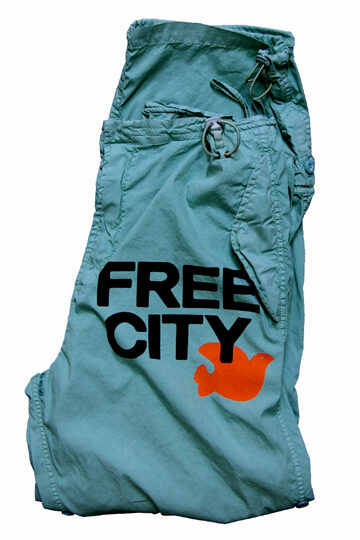
Maharishi/FREECITY snopants at FREECITYsupershop
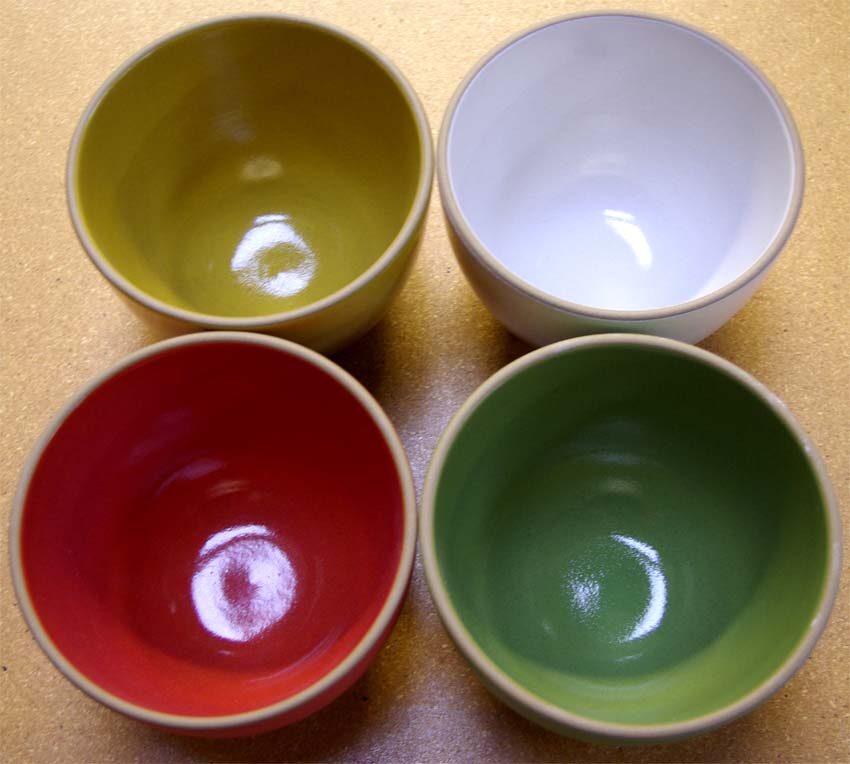
Serving bowls from Heath Ceramics at FREECITYsupershop
You’ve talked about travel and growing up in Laurel Canyon in Los Angeles in the ’70s as a big influence on your sensibility. Are there specific moments, images, music, anything, that you look back on now and think ‘wow, this really shaped who I am and how I see the world’?
I look around in my store now, and I’m realizing it has everything to do with my childhood. It’s like I’m realizing myself. I mean, that sounds totally narcissistic. It’s like you don’t even know why you’re driven to do a certain thing, and you realize it’s because it’s myself. It’s that simple and fundamental. The workshop and the store are very similar, and it’s important they are the same.
When I was a buyer, I was at the Ralph Lauren showrooms. And in Ralph Lauren, it’s the most incredible showroom, right? It’s like everything you imagine Ralph Lauren to be. And then I went to the bathroom, and it was all corporate and cold and crazy in there. And I thought, ‘oh, my god, this is who they really are!’ It was like ‘oooh, I saw it.’ It was like a movie set, and none of it’s real.
So for me, it was important to make the workshop the same as the supershop, and then I just realized it was more what I come from and who I am and what FREECITY is. It’s actually gone beyond myself, and it’s like protecting this other thing. The fact that I can look at it and go, ‘ooh, it’s all so me,’ is, you know, a point I didn’t expect to understand about myself. And it is like a mirror. And maybe it’s like someone who can really sing great, and they’re singing and they’re like ‘wow, I got to really feel all of me.’ Well, I feel it in my little way here with FREECITY. I see myself in it, I definitely do, but it’s also the bigger picture. It’s also the orchestra that’s making all the music. I just happen to be the one saying, ‘come be in my orchestra,’ and then all these incredible people are wanting to come be in this orchestra. And we’re all making this amazing music, and it’s so rewarding that way.
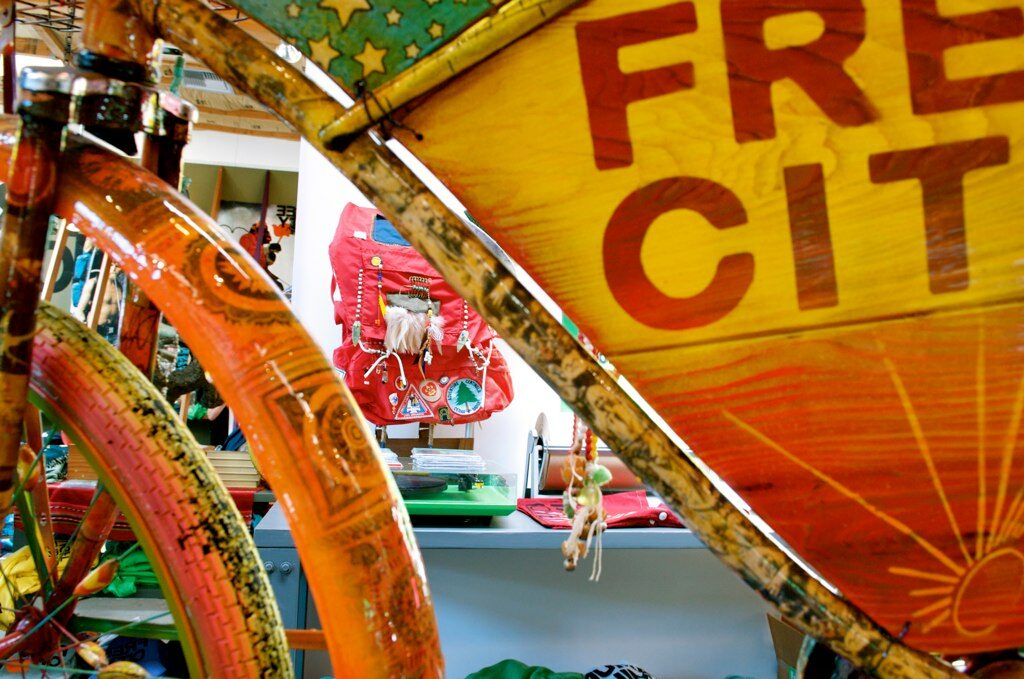
Reflections of Nina at FREECITYsupershop
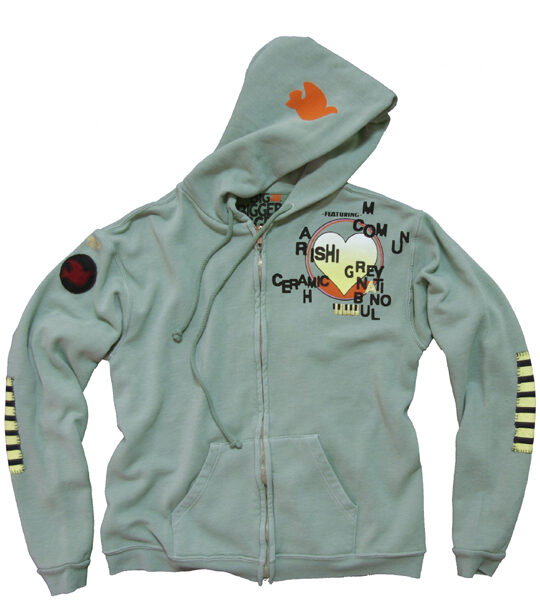
FREECITY sweatshirt paying homage to Nina’s artistic collaborators
I wanted to ask you about any other shop locations you plan, your website, or any other ways that you’re connecting with people.
The website initially, because I was so off commerce or selling it out — like a lot of celebrities wear FREECITY but I never post pictures of celebrities wearing FREECITY, I always thought it was a weird thing to do — but I started the website because internationally there are a lot of copies, so people couldn’t find us. So that’s why I started the website. First it was just supposed to be about information, about being able to at least find the real thing, about getting something authentic. And now it’s turned into a store. And so now the challenge is to be able to have it feel like something you’re inside three-dimensionally but you’re looking at on a website. So I’ve got mixed emotions about the website and about it being commerce. But on the other hand, it’s totally necessary and I think it’s making people happy, so I feel good about it.
In terms of the store, I have such a lack of faith in retail, which is one of the reasons I started this, because it was like a reaction to all of that who-cares commerce.
Do you have plans to open up other stores?
Yes, I do. I open a store on Highland [Los Angeles], and I’m just working on the lease right now. Hopefully it’ll happen in April or May. And that’s going to be the hardest thing I’ve ever done because I can’t get a loan to save my life. Perfect credit, and as long as we’ve been in business we’ve been completely independent, and I can’t get a bank to give me a line of credit. So it’s really going to be hard to do it.
Do you think this could translate into other regions outside of your immediate area?
Oh, my god, I’d love it to! I’d absolutely love it to. I’ve got total fantasies about that happening. I’d love to have a store in New York, a store in London, a store in Japan, a store in Berlin — who knows? Big or small, it doesn’t matter. Just so that somebody can have a real experience when they come to be in something. You know, for me to sell to a store and have them put my little Sending Light sweatshirt next to some other brand — you know, it’s sad for me. And I’m like, ‘OK, it’s commerce. Ouch.’ It’s painful, but it’s financing the other stuff I’m doing. So there you go, I have to ring the register, and that’s how I’m ringing it. So I’m excited about doing more shops. We’ve turned down a lot of money and finance, and I don’t have any regrets about that. I’m fine with that. I don’t need to be loaded, I’m fine with it. I’m just really interested in preserving this and keeping it real.

SAME HEART TOKYO BOUND with Seilin & Co.
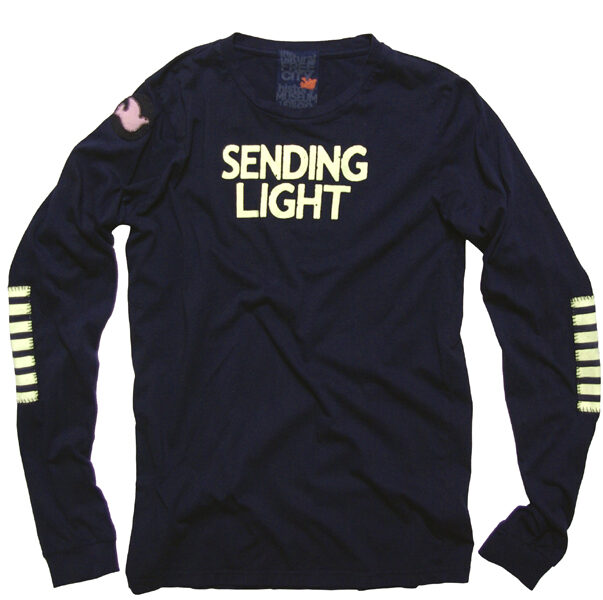
SENDING LIGHT t-shirt from FREECITYsupershop
I can’t wrap up this interview without asking you about your Artists Wanted program. Is that a program you’re still doing, and where do you see this going?
Yeah, we do it 365 days a year. We wholesale it to people that buy the other stuff. And it’s $75 for the t-shirt — it’s $75 when we sell it to another store, and they sell it in their store for $75, just to make sure nobody’s putting a penny in their pocket. It pays for itself completely, and then the rest goes to some known institutions. And one went to Margo Victor — she’s a filmmaker and kind of like a Renaissance artist, she can do anything. So that’s something we don’t get a tax write-off on, but that’s not the point. So it’s gone to great things — it’s gone to Habitat for Humanity, the Musicians’ Fund, it’s gone to the Baryshnikov Dance Academy, it’s gone to the Silverlake Conservatory of Music, it’s gone to Project Angel Food. It’s going to go to Blunk this year. So the idea is that you’re paying $75, but you’re giving $7500 to your little group. It’s helped with projects that we’ve done — it helped with a temporary store we did in Tokyo.
It’s something we don’t advertise because I always think that’s totally weird, you know, like Gap and RED. You know, there’s two ways to look at this. It’s like, yeah, they’ve helped bring awareness and money to impoverished Africa and AIDS — and thank god for that — but on the other hand, they’re rich too because of it. I just think it’s wrong, I just do. It rubs me really wrong. So a lot of people have this t-shirt and don’t know — I think I’d sell a lot more if I advertised it! I don’t know, it’s difficult. The point is to help as many people as possible, but I never want anyone to feel like I’m using it to serve myself, because it was not intended for that.
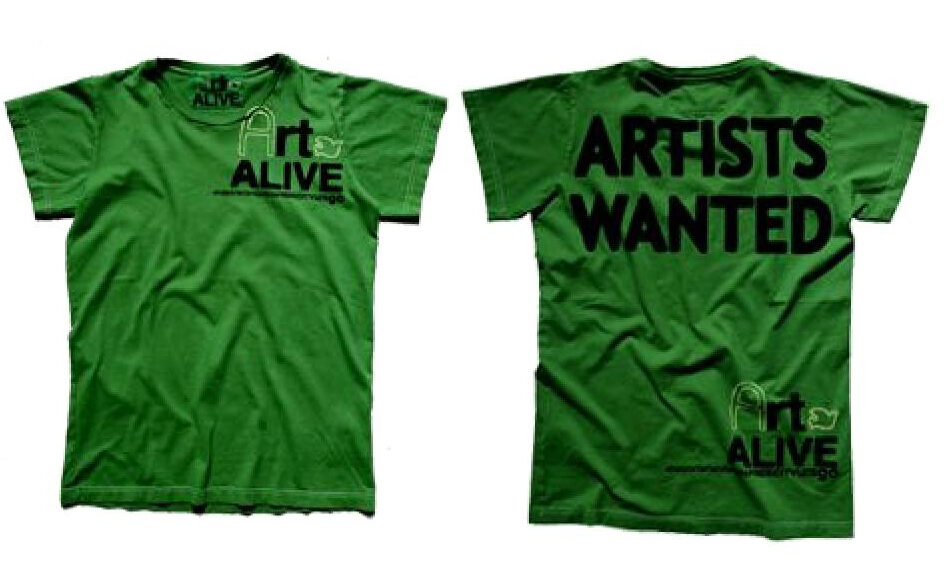
ARTISTS WANTED t-shirt at FREECITYsupershop
I went to the Saatchi Gallery in London right before I started the Artists Wanted t-shirt, and I was so moved by all of these paintings. It was so brilliant and beautiful and sublime. God, when you see a great painting — or a great anything — you can just go to tears, you know? And I was like, ‘wow, what can we do?’ I know I can make a t-shirt, I can do that, and I can give away that t-shirt. If it pays for itself, I can definitely do that. We can all do something, so that’s how we do it.
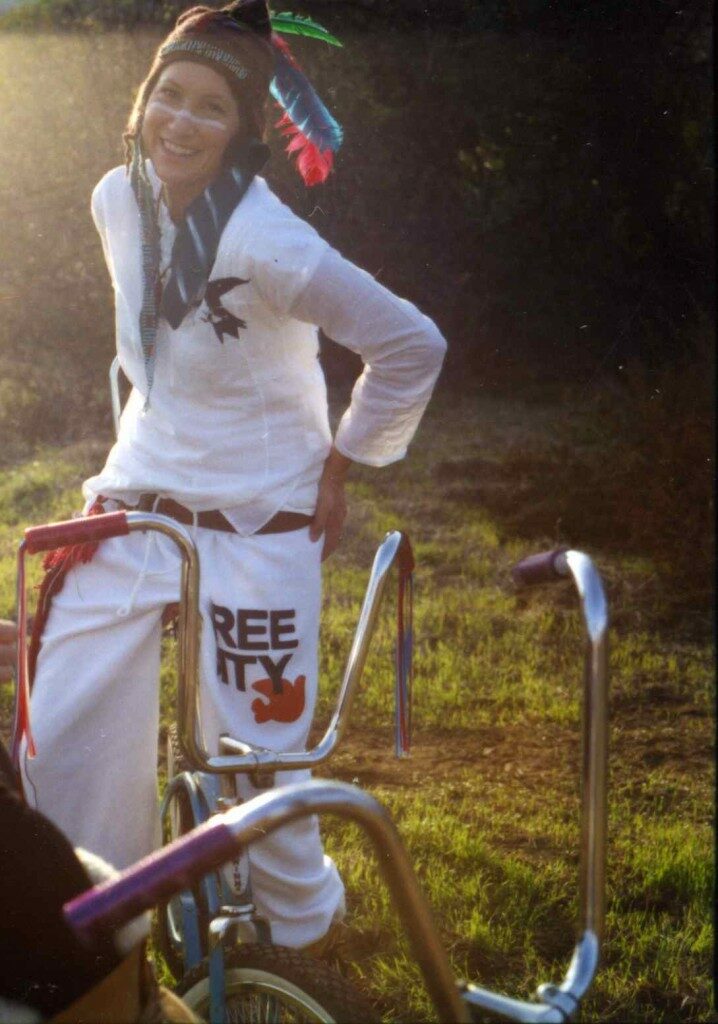
Nina Garduno
Share the love, post a comment!

